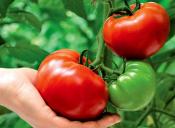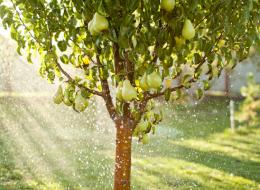Search
Login
Recommended
Water the garden, how to do it right, the art of watering the garden
Irrigation is one of the main components of optimal care for garden plants. The key to the abundant fruiting of trees and the unfading of the garden is timely and proper watering.
How plentiful and how often do I need to water the trees? How to choose an irrigation method and system? Answers to these questions will allow you to competently organize watering and increase the yield of fruit crops.
Content
- The Importance of Watering Garden Plants
- Oriented timelines and watering rates
- Garden Watering Guide
- Garden Irrigation Methods
- Automatic watering
The Importance of Watering Garden Plants
Most fruit trees and berry bushes love moisture and do not tolerate drought. With a significant decrease in humidity, trees add little to growth, bear less fruit, lose frost resistance and durability.

At sources of water the richest vegetation is always concentrated. Indeed, it is through water that all nutrients from the soil enter the plants. Water acts as a regulator of plant temperature, protecting them in hot weather.
It is believed that watering the garden should be done when the level of maximum field moisture capacity (maximum water content in the soil after flooding) is below 70%. It is necessary to take into account the air humidity, hoping that the lower it is (dry, hot weather), the more often soil moisture is required. The maximum humidity is observed in fog (100%).
Among fruit treesare most demanding for regular watering: apple tree, plum and pear. Cherry is the least susceptible to drought.
Oriented timelines and watering rates
fruit trees
It is recommended to water fruit trees with the onset of phenophase of vegetative growth, the formation of fruits and the laying of flower buds for next year.

Pears and apple trees are watered as follows:
- in early June after the excess ovary falls;
- in mid-July, watering is carried out 2-3 weeks before the fruits ripen and contributes to their filling;
- end of August or beginning of September irrigation for winter-winter varieties (if the summer was arid, then general garden watering is carried out).
The order of irrigation of cherries and plums:
- late May or early June during the period of active growth of shoots;
- approximately 2 weeks before the fruit fully ripens (watering the trees will help prevent dropping of the ovary);
- after fruiting and harvesting.
Stages of watering young non-bearing trees:
- during the formation of fruit ovary;
- during fruit ripening;
- after harvesting.
If winter was not snowy and the soil is not sufficiently saturated with moisture, then additional irrigation is carried out for all trees before buds open.
Irrigation rate in home gardening is from 40 to 100 liters of water per 1 square meter. Water consumption varies depending on the quality of the soil and the purpose of irrigation. For young trees, the norm is reduced (so as not to provoke rotting of the roots), and on clay soils increased to 120 liters.
berry bushes
Watering or spraying shrubs (raspberries, gooseberries, currants) gives a positive result during the budding and ovary season. Effective spraying involves the complete wetting of leaves, branches and trunks with water.

You can not water berry bushes in early spring, this will provoke premature budding of the buds, which can undergo freezing and fall. For the competent preparation of shrubs for winter, it is not recommended to moisten the soil in late autumn.
Watering rates for berry bushes:
- gooseberry 10 l. water based on 2-3 bushes;
- raspberries 20-35 liters of water per 1 square meter (depending on soil composition);
- red and black currants 20-45 liters.
During winter-time water-loading irrigation (during the period of leaf fall), water consumption can be doubled.
Garden Watering Guide

Consider the general rules of how to effectively water trees and shrubs:
- The optimal time for irrigation is 6-7 in the morning and 9-10 in the evening, that is, the period when the sun does not take care of the leaves of the plants.
- In order to determine the need for watering, you need to dig a handful of earth in the aisles of the garden from a depth of 30-40 cm and squeeze it in your hand. If a lump is formed, watering is not needed, if it crumbles into grains, it's time to moisten the soil.
- Water should not be cold (well, spring). The optimum temperature of the water is approximately equal to the temperature of the soil.
- Garden irrigation should be started without waiting for the topsoil to completely dry out.
- Garden watering is rare, but plentiful.
- Chernozem and clay soil retain moisture better than sandy soils.
- Loosening the earth allows longer to retain moisture in the soil.
- A good lingering rain equates to watering, and light rain pushes the watering period for a week.
Garden Irrigation Methods
For irrigation of garden plants, depending on the type of water supply, three methods are used:
- drip irrigation;
- surface irrigation (direct water supply);
- irrigation irrigation.

Drop watering can be used to effectively fertilize the root system of trees and shrubs. Dosed feed allows rational use of water. This method of irrigation is indispensable in windy areas.

Surface irrigation is often used on soils with poor absorption, which allows you to create an optimal supply of moisture. Watering trees in summer is superficial in furrows, hole-rings or bowls.
For surface irrigation in large gardens, it is necessary to lay a metal pipeline. Compact garden areas can be watered by laying deep furrows before each irrigation.

During sprinkling, the soil, air above the soil and the ground part of the plants are moistened. The main advantage of the method is that the structure of the irrigated soil is not damaged.
Irrigation can be carried out manually (through a hose, a hydrant for irrigation of the garden), by installing an irrigation system with sprayers or by installing automatic irrigation.
Automatic watering
Irrigation system features
Over the past decades, the technology of watering garden plots has been automated and improved. The possibility of automatic irrigation to irrigate the soil in various ways and at any time significantly expanded the scope of its application (gardens, landscape design, stadiums, urban flower beds and garden plots).

Automatic garden watering has several advantages:
- the versatility of the irrigation system provides care for a wide range of plants;
- the ability to carry out irrigation at night, when the evaporation of moisture is minimal;
- reduction of time and effort to irrigate the site;
- water consumption is reduced by almost 50%;
- increasing productivity and giving the garden a beautiful, fragrant appearance;
- there is no need to make furrows and trenches to direct the flow of water.
Operational Features
For the smooth operation of the autowatering system of the garden, you need to know some of the nuances of its installation and operation.

Consider the most important points of the effective operation of automatic irrigation:
- providing a reliable source of water (water supply);
- to maintain a constant pressure (4-6 Bar), a storage tank with a pump is installed;
- the use of water from natural reservoirs can lead to a malfunction of the system;
- so that the system does not interfere with mowing the lawn, sprinkler heads must be installed at the level of the soil (sprayers rise with the beginning of irrigation);
- sprinklers should be evenly distributed throughout the garden, avoiding the appearance of dead watering zones;
- it is necessary to provide for manual watering.
Competent and timely provision of an optimal water regime for plants will make it possible to annually receive a high yield and enjoy the splendor of a well-groomed garden.





